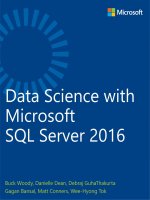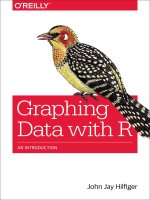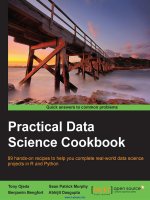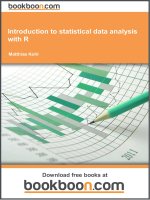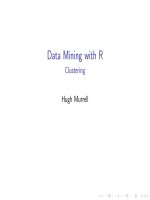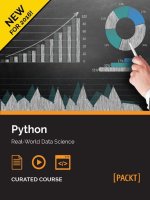Practical data science with r
Bạn đang xem bản rút gọn của tài liệu. Xem và tải ngay bản đầy đủ của tài liệu tại đây (20.83 MB, 417 trang )
Nina Zumel
John Mount
FOREWORD BY Jim Porzak
MANNING
www.it-ebooks.info
Practical Data Science with R
www.it-ebooks.info
www.it-ebooks.info
Practical Data
Science with R
NINA ZUMEL
JOHN MOUNT
MANNING
SHELTER ISLAND
www.it-ebooks.info
For online information and ordering of this and other Manning books, please visit
www.manning.com. The publisher offers discounts on this book when ordered in quantity.
For more information, please contact
Special Sales Department
Manning Publications Co.
20 Baldwin Road
PO Box 261
Shelter Island, NY 11964
Email:
©2014 by Manning Publications Co. All rights reserved.
No part of this publication may be reproduced, stored in a retrieval system, or transmitted, in
any form or by means electronic, mechanical, photocopying, or otherwise, without prior written
permission of the publisher.
Many of the designations used by manufacturers and sellers to distinguish their products are
claimed as trademarks. Where those designations appear in the book, and Manning
Publications was aware of a trademark claim, the designations have been printed in initial caps
or all caps.
Recognizing the importance of preserving what has been written, it is Manning’s policy to have
the books we publish printed on acid-free paper, and we exert our best efforts to that end.
Recognizing also our responsibility to conserve the resources of our planet, Manning books
are printed on paper that is at least 15 percent recycled and processed without the use of
elemental chlorine.
Manning Publications Co.
20 Baldwin Road
PO Box 261
Shelter Island, NY 11964
Development editor:
Copyeditor:
Proofreader:
Typesetter:
Cover designer:
ISBN 9781617291562
Printed in the United States of America
1 2 3 4 5 6 7 8 9 10 – EBM – 19 18 17 16 15 14
www.it-ebooks.info
Cynthia Kane
Benjamin Berg
Katie Tennant
Dottie Marsico
Marija Tudor
To our parents
Olive and Paul Zumel
Peggy and David Mount
www.it-ebooks.info
www.it-ebooks.info
brief contents
PART 1 INTRODUCTION TO DATA SCIENCE .................................1
1
2
3
4
■
■
■
■
The data science process
Loading data into R 18
Exploring data 35
Managing data 64
3
PART 2 MODELING METHODS ..................................................81
5
6
7
8
9
■
■
■
■
■
Choosing and evaluating models 83
Memorization methods 115
Linear and logistic regression 140
Unsupervised methods 175
Exploring advanced methods 211
PART 3 DELIVERING RESULTS . ...............................................253
10
11
■
■
Documentation and deployment 255
Producing effective presentations 287
vii
www.it-ebooks.info
www.it-ebooks.info
contents
foreword xv
preface xvii
acknowledgments xviii
about this book xix
about the cover illustration
PART 1
1
xxv
INTRODUCTION TO DATA SCIENCE......................1
The data science process
1.1
The roles in a data science project
Project roles
1.2
3
3
4
Stages of a data science project
6
Defining the goal 7 Data collection and management 8
Modeling 10 Model evaluation and critique 11
Presentation and documentation 13 Model deployment and
maintenance 14
■
■
■
1.3
Setting expectations 14
Determining lower and upper bounds on model performance
1.4
Summary
17
ix
www.it-ebooks.info
15
x
CONTENTS
2
Loading data into R
2.1
18
Working with data from files 19
Working with well-structured data from files or URLs 19
Using R on less-structured data 22
2.2
Working with relational databases 24
A production-size example 25 Loading data from a database
into R 30 Working with the PUMS data 31
■
■
2.3
3
Summary
Exploring data
3.1
34
35
Using summary statistics to spot problems
Typical problems revealed by data summaries
3.2
36
38
Spotting problems using graphics and visualization 41
Visually checking distributions for a single variable 43
Visually checking relationships between two variables 51
3.3
4
Summary
Managing data
4.1
62
64
Cleaning data
64
Treating missing values (NAs) 65
4.2
■
Data transformations
Sampling for modeling and validation
69
76
Test and training splits 76 Creating a sample group
column 77 Record grouping 78 Data provenance 78
■
■
4.3
PART 2
5
Summary
■
79
MODELING METHODS ......................................81
Choosing and evaluating models
5.1
83
Mapping problems to machine learning tasks
84
Solving classification problems 85 Solving scoring
problems 87 Working without known targets 88
Problem-to-method mapping 90
■
■
5.2
Evaluating models
92
Evaluating classification models 93 Evaluating scoring
models 98 Evaluating probability models 101 Evaluating
ranking models 105 Evaluating clustering models 105
■
■
■
■
www.it-ebooks.info
xi
CONTENTS
5.3
Validating models
108
Identifying common model problems 108 Quantifying model
soundness 110 Ensuring model quality 111
■
■
5.4
6
Summary
113
Memorization methods 115
6.1
KDD and KDD Cup 2009 116
Getting started with KDD Cup 2009 data
6.2
Building single-variable models
117
118
Using categorical features 119 Using numeric features 121
Using cross-validation to estimate effects of overfitting 123
■
6.3
Building models using many variables
125
Variable selection 125 Using decision trees 127
nearest neighbor methods 130 Using Naive Bayes
■
■
6.4
7
Summary
■
Using
134
138
Linear and logistic regression 140
7.1
Using linear regression
141
Understanding linear regression 141 Building a linear
regression model 144 Making predictions 145 Finding
relations and extracting advice 149 Reading the model summary
and characterizing coefficient quality 151 Linear regression
takeaways 156
■
■
■
■
■
7.2
Using logistic regression
157
Understanding logistic regression 157 Building a logistic
regression model 159 Making predictions 160 Finding
relations and extracting advice from logistic models 164
Reading the model summary and characterizing coefficients 166
Logistic regression takeaways 173
■
■
7.3
8
Summary
174
Unsupervised methods
8.1
■
175
Cluster analysis
176
Distances 176 Preparing the data 178 Hierarchical
clustering with hclust() 180 The k-means algorithm 190
Assigning new points to clusters 195 Clustering
takeaways 198
■
■
■
■
www.it-ebooks.info
xii
CONTENTS
8.2
Association rules
198
Overview of association rules 199 The example problem
Mining association rules with the arules package 201
Association rule takeaways 209
■
8.3
9
Summary
209
Exploring advanced methods
9.1
200
211
Using bagging and random forests
to reduce training variance 212
Using bagging to improve prediction 213 Using random forests
to further improve prediction 216 Bagging and random forest
takeaways 220
■
■
9.2
Using generalized additive models (GAMs) to learn nonmonotone relationships 221
Understanding GAMs 221 A one-dimensional regression
example 222 Extracting the nonlinear relationships 226
Using GAM on actual data 228 Using GAM for logistic
regression 231 GAM takeaways 233
■
■
■
■
9.3
Using kernel methods to increase data separation 233
Understanding kernel functions 234 Using an explicit kernel on
a problem 238 Kernel takeaways 241
■
■
9.4
Using SVMs to model complicated decision
boundaries 242
Understanding support vector machines 242 Trying an SVM on
artificial example data 245 Using SVMs on real data 248
Support vector machine takeaways 251
■
■
9.5
PART 3
10
Summary
251
DELIVERING RESULTS . ...................................253
Documentation and deployment
10.1
10.2
255
The buzz dataset 256
Using knitr to produce milestone documentation
What is knitr? 258 knitr technical details
to document the buzz data 262
■
www.it-ebooks.info
261
■
258
Using knitr
xiii
CONTENTS
10.3
Using comments and version control for running
documentation 266
Writing effective comments 266 Using version control to record
history 267 Using version control to explore your project 272
Using version control to share work 276
■
■
10.4
Deploying models
280
Deploying models as R HTTP services 280
export 283 What to take away 284
■
Deploying models by
■
10.5
11
Summary
286
Producing effective presentations
11.1
287
Presenting your results to the project sponsor 288
Summarizing the project’s goals 289 Stating the project’s
results 290 Filling in the details 292 Making
recommendations and discussing future work 294
Project sponsor presentation takeaways 295
■
■
11.2
■
Presenting your model to end users
295
Summarizing the project’s goals 296 Showing how the model fits
the users’ workflow 296 Showing how to use the model 299
End user presentation takeaways 300
■
■
11.3
Presenting your work to other data scientists
301
Introducing the problem 301 Discussing related work 302
Discussing your approach 302 Discussing results and future
work 303 Peer presentation takeaways 304
■
■
■
11.4
appendix A
appendix B
appendix C
Summary
304
Working with R and other tools 307
Important statistical concepts 333
More tools and ideas worth exploring 369
bibliography 375
index 377
www.it-ebooks.info
www.it-ebooks.info
foreword
If you’re a beginning data scientist, or want to be one, Practical Data Science with R
(PDSwR) is the place to start. If you’re already doing data science, PDSwR will fill in
gaps in your knowledge and even give you a fresh look at tools you use on a daily
basis—it did for me.
While there are many excellent books on statistics and modeling with R, and a few
good management books on applying data science in your organization, this book is
unique in that it combines solid technical content with practical, down-to-earth advice
on how to practice the craft. I would expect no less from Nina and John.
I first met John when he presented at an early Bay Area R Users Group about his
joys and frustrations with R. Since then, Nina, John, and I have collaborated on a couple of projects for my former employer. And John has presented early ideas from
PDSwR—both to the “big” group and our Berkeley R-Beginners meetup. Based on his
experience as a practicing data scientist, John is outspoken and has strong views about
how to do things. PDSwR reflects Nina and John’s definite views on how to do data science—what tools to use, the process to follow, the important methods, and the importance of interpersonal communications. There are no ambiguities in PDSwR.
This, as far as I’m concerned, is perfectly fine, especially since I agree with 98% of
their views. (My only quibble is around SQL—but that’s more an issue of my upbringing than of disagreement.) What their unambiguous writing means is that you can
focus on the craft and art of data science and not be distracted by choices of which
tools and methods to use. This precision is what makes PDSwR practical. Let’s look at
some specifics.
Practical tool set: R is a given. In addition, RStudio is the IDE of choice; I’ve been
using RStudio since it came out. It has evolved into a remarkable tool—integrated
xv
www.it-ebooks.info
xvi
FOREWORD
debugging is in the latest version. The third major tool choice in PDSwR is Hadley
Wickham’s ggplot2. While R has traditionally included excellent graphics and visualization tools, ggplot2 takes R visualization to the next level. (My practical hint: take a
close look at any of Hadley’s R packages, or those of his students.) In addition to those
main tools, PDSwR introduces necessary secondary tools: a proper SQL DBMS for
larger datasets; Git and GitHub for source code version control; and knitr for documentation generation.
Practical datasets: The only way to learn data science is by doing it. There’s a big
leap from the typical teaching datasets to the real world. PDSwR strikes a good balance
between the need for a practical (simple) dataset for learning and the messiness of
the real world. PDSwR walks you through how to explore a new dataset to find problems in the data, cleaning and transforming when necessary.
Practical human relations: Data science is all about solving real-world problems for
your client—either as a consultant or within your organization. In either case, you’ll
work with a multifaceted group of people, each with their own motivations, skills, and
responsibilities. As practicing consultants, Nina and John understand this well. PDSwR
is unique in stressing the importance of understanding these roles while working
through your data science project.
Practical modeling: The bulk of PDSwR is about modeling, starting with an excellent overview of the modeling process, including how to pick the modeling method to
use and, when done, gauge the model’s quality. The book walks you through the most
practical modeling methods you’re likely to need. The theory behind each method is
intuitively explained. A specific example is worked through—the code and data are
available on the authors’ GitHub site. Most importantly, tricks and traps are covered.
Each section ends with practical takeaways.
In short, Practical Data Science with R is a unique and important addition to any data
scientist’s library.
JIM PORZAK
SENIOR DATA SCIENTIST AND
COFOUNDER OF THE BAY AREA R USERS GROUP
www.it-ebooks.info
preface
This is the book we wish we’d had when we were teaching ourselves that collection of
subjects and skills that has come to be referred to as data science. It’s the book that we’d
like to hand out to our clients and peers. Its purpose is to explain the relevant parts of
statistics, computer science, and machine learning that are crucial to data science.
Data science draws on tools from the empirical sciences, statistics, reporting, analytics, visualization, business intelligence, expert systems, machine learning, databases,
data warehousing, data mining, and big data. It’s because we have so many tools that
we need a discipline that covers them all. What distinguishes data science itself from
the tools and techniques is the central goal of deploying effective decision-making
models to a production environment.
Our goal is to present data science from a pragmatic, practice-oriented viewpoint.
We’ve tried to achieve this by concentrating on fully worked exercises on real data—
altogether, this book works through over 10 significant datasets. We feel that this
approach allows us to illustrate what we really want to teach and to demonstrate all the
preparatory steps necessary to any real-world project.
Throughout our text, we discuss useful statistical and machine learning concepts,
include concrete code examples, and explore partnering with and presenting to nonspecialists. We hope if you don’t find one of these topics novel, that we’re able to shine
a light on one or two other topics that you may not have thought about recently.
xvii
www.it-ebooks.info
acknowledgments
We wish to thank all the many reviewers, colleagues, and others who have read and
commented on our early chapter drafts, especially Aaron Colcord, Aaron Schumacher,
Ambikesh Jayal, Bryce Darling, Dwight Barry, Fred Rahmanian, Hans Donner, Jeelani
Basha, Justin Fister, Dr. Kostas Passadis, Leo Polovets, Marius Butuc, Nathanael Adams,
Nezih Yigitbasi, Pablo Vaselli, Peter Rabinovitch, Ravishankar Rajagopalan, Rodrigo
Abreu, Romit Singhai, Sampath Chaparala, and Zekai Otles. Their comments, questions, and corrections have greatly improved this book. Special thanks to George
Gaines for his thorough technical review of the manuscript shortly before it went into
production.
We especially would like to thank our development editor, Cynthia Kane, for all
her advice and patience as she shepherded us through the writing process. The same
thanks go to Benjamin Berg, Katie Tennant, Kevin Sullivan, and all the other editors
at Manning who worked hard to smooth out the rough patches and technical glitches
in our text.
In addition, we’d like to thank our colleague David Steier, Professors Anno Saxenian and Doug Tygar from UC Berkeley’s School of Information Science, as well as all
the other faculty and instructors who have reached out to us about the possibility of
using this book as a teaching text.
We’d also like to thank Jim Porzak for inviting one of us (John Mount) to speak at
the Bay Area R Users Group, for being an enthusiastic advocate of our book, and for
contributing the foreword. On days when we were tired and discouraged and wondered why we had set ourselves to this task, his interest helped remind us that there’s a
need for what we’re offering and for the way that we’re offering it. Without his
encouragement, completing this book would have been much harder.
xviii
www.it-ebooks.info
about this book
This book is about data science: a field that uses results from statistics, machine learning, and computer science to create predictive models. Because of the broad nature of
data science, it’s important to discuss it a bit and to outline the approach we take in
this book.
What is data science?
The statistician William S. Cleveland defined data science as an interdisciplinary field
larger than statistics itself. We define data science as managing the process that can
transform hypotheses and data into actionable predictions. Typical predictive analytic
goals include predicting who will win an election, what products will sell well together,
which loans will default, or which advertisements will be clicked on. The data scientist
is responsible for acquiring the data, managing the data, choosing the modeling technique, writing the code, and verifying the results.
Because data science draws on so many disciplines, it’s often a “second calling.”
Many of the best data scientists we meet started as programmers, statisticians, business
intelligence analysts, or scientists. By adding a few more techniques to their repertoire, they became excellent data scientists. That observation drives this book: we
introduce the practical skills needed by the data scientist by concretely working
through all of the common project steps on real data. Some steps you’ll know better
than we do, some you’ll pick up quickly, and some you may need to research further.
Much of the theoretical basis of data science comes from statistics. But data science
as we know it is strongly influenced by technology and software engineering methodologies, and has largely evolved in groups that are driven by computer science and
xix
www.it-ebooks.info
xx
ABOUT THIS BOOK
information technology. We can call out some of the engineering flavor of data science by listing some famous examples:
Amazon’s product recommendation systems
Google’s advertisement valuation systems
LinkedIn’s contact recommendation system
Twitter’s trending topics
Walmart’s consumer demand projection systems
These systems share a lot of features:
All of these systems are built off large datasets. That’s not to say they’re all in the
realm of big data. But none of them could’ve been successful if they’d only used
small datasets. To manage the data, these systems require concepts from computer science: database theory, parallel programming theory, streaming data
techniques, and data warehousing.
Most of these systems are online or live. Rather than producing a single report
or analysis, the data science team deploys a decision procedure or scoring procedure to either directly make decisions or directly show results to a large number of end users. The production deployment is the last chance to get things
right, as the data scientist can’t always be around to explain defects.
All of these systems are allowed to make mistakes at some non-negotiable rate.
None of these systems are concerned with cause. They’re successful when they
find useful correlations and are not held to correctly sorting cause from effect.
This book teaches the principles and tools needed to build systems like these. We
teach the common tasks, steps, and tools used to successfully deliver such projects.
Our emphasis is on the whole process—project management, working with others,
and presenting results to nonspecialists.
Roadmap
This book covers the following:
Managing the data science process itself. The data scientist must have the ability
to measure and track their own project.
Applying many of the most powerful statistical and machine learning techniques used in data science projects. Think of this book as a series of explicitly
worked exercises in using the programming language R to perform actual data
science work.
Preparing presentations for the various stakeholders: management, users,
deployment team, and so on. You must be able to explain your work in concrete
terms to mixed audiences with words in their common usage, not in whatever
technical definition is insisted on in a given field. You can’t get away with just
throwing data science project results over the fence.
www.it-ebooks.info
ABOUT THIS BOOK
xxi
We’ve arranged the book topics in an order that we feel increases understanding. The
material is organized as follows.
Part 1 describes the basic goals and techniques of the data science process, emphasizing collaboration and data.
Chapter 1 discusses how to work as a data scientist, and chapter 2 works through
loading data into R and shows how to start working with R.
Chapter 3 teaches what to first look for in data and the important steps in characterizing and understanding data. Data must be prepared for analysis, and data issues
will need to be corrected, so chapter 4 demonstrates how to handle those things.
Part 2 moves from characterizing data to building effective predictive models.
Chapter 5 supplies a starting dictionary mapping business needs to technical evaluation and modeling techniques.
Chapter 6 teaches how to build models that rely on memorizing training data.
Memorization models are conceptually simple and can be very effective. Chapter 7
moves on to models that have an explicit additive structure. Such functional structure
adds the ability to usefully interpolate and extrapolate situations and to identify
important variables and effects.
Chapter 8 shows what to do in projects where there is no labeled training data
available. Advanced modeling methods that increase prediction performance and fix
specific modeling issues are introduced in chapter 9.
Part 3 moves away from modeling and back to process. We show how to deliver
results. Chapter 10 demonstrates how to manage, document, and deploy your models.
You’ll learn how to create effective presentations for different audiences in chapter 11.
The appendixes include additional technical details about R, statistics, and more
tools that are available. Appendix A shows how to install R, get started working, and
work with other tools (such as SQL). Appendix B is a refresher on a few key statistical
ideas. Appendix C discusses additional tools and research ideas. The bibliography
supplies references and opportunities for further study.
The material is organized in terms of goals and tasks, bringing in tools as they’re
needed. The topics in each chapter are discussed in the context of a representative
project with an associated dataset. You’ll work through 10 substantial projects over the
course of this book. All the datasets referred to in this book are at the book’s GitHub
repository, You can download the entire
repository as a single zip file (one of GitHub’s services), clone the repository to your
machine, or copy individual files as needed.
Audience
To work the examples in this book, you’ll need some familiarity with R, statistics, and
(for some examples) SQL databases. We recommend you have some good introductory texts on hand. You don’t need to be an expert in R, statistics, and SQL before
starting the book, but you should be comfortable tutoring yourself on topics that we
mention but can’t cover completely in our book.
www.it-ebooks.info
xxii
ABOUT THIS BOOK
For R, we recommend R in Action, Second Edition, by Robert Kabacoff (www. manning.com/kabacoff2/), along with the text’s associated website, Quick-R (www.statmethods.net). For statistics, we recommend Statistics, Fourth Edition by David
Freedman, Robert Pisani, and Roger Purves. For SQL, we recommend SQL for Smarties,
Fourth Edition by Joe Celko.
In general, here’s what we expect from our ideal reader:
An interest in working examples. By working through the examples, you’ll learn at
least one way to perform all steps of a project. You must be willing to attempt
simple scripting and programming to get the full value of this book. For each
example we work, you should try variations and expect both some failures
(where your variations don’t work) and some successes (where your variations
outperform our example analyses).
Some familiarity with the R statistical system and the will to write short scripts and programs in R. In addition to Kabacoff, we recommend a few good books in the bibliography. We work specific problems in R; to understand what’s going on,
you’ll need to run the examples and read additional documentation to understand variations of the commands we didn’t demonstrate.
Some experience with basic statistical concepts such as probabilities, means, standard deviations, and significance. We introduce these concepts as needed, but you may
need to read additional references as we work through examples. We define
some terms and refer to some topic references and blogs where appropriate.
But we expect you will have to perform some of your own internet searches on
certain topics.
A computer (OS X, Linux, or Windows) to install R and other tools on, as well as internet
access to download tools and datasets. We strongly suggest working through the
examples, examining R help() on various methods, and following up some of
the additional references.
What is not in this book?
This book is not an R manual. We use R to concretely demonstrate the important
steps of data science projects. We teach enough R for you to work through the examples, but a reader unfamiliar with R will want to refer to appendix A as well as to the
many excellent R books and tutorials already available.
This book is not a set of case studies. We emphasize methodology and technique.
Example data and code is given only to make sure we’re giving concrete usable advice.
This book is not a big data book. We feel most significant data science occurs at a
database or file manageable scale (often larger than memory, but still small enough to
be easy to manage). Valuable data that maps measured conditions to dependent outcomes tends to be expensive to produce, and that tends to bound its size. For some
report generation, data mining, and natural language processing, you’ll have to move
into the area of big data.
www.it-ebooks.info
ABOUT THIS BOOK
xxiii
This is not a theoretical book. We don’t emphasize the absolute rigorous theory of
any one technique. The goal of data science is to be flexible, have a number of good
techniques available, and be willing to research a technique more deeply if it appears
to apply to the problem at hand. We prefer R code notation over beautifully typeset
equations even in our text, as the R code can be directly used.
This is not a machine learning tinkerer’s book. We emphasize methods that are
already implemented in R. For each method, we work through the theory of operation and show where the method excels. We usually don’t discuss how to implement
them (even when implementation is easy), as that information is readily available.
Code conventions and downloads
This book is example driven. We supply prepared example data at the GitHub repository ( with R code and links back to original sources. You can explore this repository online or clone it onto your own
machine. We also supply the code to produce all results and almost all graphs found
in the book as a zip file ( />CodeExamples.zip), since copying code from the zip file can be easier than copying
and pasting from the book. You can also download the code from the publisher’s website at www.manning.com/PracticalDataSciencewithR.
We encourage you to try the example R code as you read the text; even when we
discuss fairly abstract aspects of data science, we illustrate examples with concrete data
and code. Every chapter includes links to the specific dataset(s) that it references.
In this book, code is set with a fixed-width font like this to distinguish it from
regular text. Concrete variables and values are formatted similarly, whereas abstract
math will be in italic font like this. R is a mathematical language, so many phrases read
correctly in either font. In our examples, any prompts such as > and $ are to be
ignored. Inline results may be prefixed by R’s comment character #.
Software and hardware requirements
To work through our examples, you’ll need some sort of computer (Linux, OS X, or
Windows) with software installed (installation described in appendix A). All of the
software we recommend is fully cross-platform (Linux, OS X, or Windows), freely available, and usually open source.
We suggest installing at least the following:
R itself: .
Various packages from CRAN (installed by R itself using the install.packages()
command and activated using the library() command).
Git for version control: .
RStudio for an integrated editor, execution and graphing environment—http://
www.rstudio.com.
A bash shell for system commands. This is built-in for Linux and OS X, and can
be added to Windows by installing Cygwin (). We don’t
www.it-ebooks.info
xxiv
ABOUT THIS BOOK
write any scripts, so an experienced Windows shell user can skip installing Cygwin if they’re able to translate our bash commands into the appropriate Windows commands.
Author Online
The purchase of Practical Data Science with R includes free access to a private web
forum run by Manning Publications, where you can make comments about the book,
ask technical questions, and receive help from the authors and from other users. To
access the forum and subscribe to it, point your web browser to www.manning.com/
PracticalDataSciencewithR. This page provides information on how to get on the
forum once you are registered, what kind of help is available, and the rules of conduct
on the forum.
Manning’s commitment to our readers is to provide a venue where a meaningful
dialogue between individual readers and between readers and the authors can take
place. It is not a commitment to any specific amount of participation on the part of
the authors, whose contribution to the forum remains voluntary (and unpaid). We
suggest you try asking the authors some challenging questions lest their interest stray!
The Author Online forum and the archives of previous discussions will be accessible from the publisher’s website as long as the book is in print.
About the authors
NINA ZUMEL has worked as a scientist at SRI International, an independent, nonprofit research institute. She has worked as chief scientist of a price optimization company and founded a contract
research company. Nina is now a principal consultant at Win-Vector
LLC. She can be reached at
JOHN MOUNT has worked as a computational scientist in biotechnology and as a stock trading algorithm designer, and has managed
a research team for Shopping.com. He is now a principal consultant at Win-Vector LLC. John can be reached at
www.it-ebooks.info


